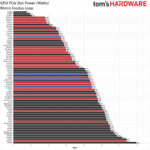JarredWaltonGPU
Splendid
Soldering is relatively simple if you have:Just a heads up to the writer: soldering should be easy. I worry that if you struggled, that your joints may be bad.
A bad solder joint can increase resistance through a connection; this could invalidate your test results (like putting a resistor in the wires)
I assume you were soldering wires by the article; I'm sure there's plenty of videos online but simply twist the wires (see below for a great example of doing a straight connection) and apply heat to the joint, then feed the solder into the joint; you need to heat the joint (not solder) so that the solder can flow onto the joint, there is flux inside the solder (hence flux core) - that flux is needed to strip the oxide layer off the wire so that the solder will actually attach/wick into the wire. Worst case, you can apply some extra flux to the connection yourself first, but once you get the technique down, you should be able to feed in the flux from the flux core solder (and also feed solder into your joint at the same time) .. Also if adding extra flux, it's always a good idea to clean it (iso) as some fluxes can cause corrosion on the joint after if they are left on (it is afterall flux's job to eat the protective oxide layer..)
- Experience soldering
- A good quality soldering iron
- Good solder
I almost never solder anything, so I lack all three, and the join is from a wire to the PCB. Soldering two wires together is very easy in comparison to getting a wire to solder onto a very small pin (~3mm high, maybe). But it's done, and everything seems to be working as expected. It's a learning curve, though, and one I probably won't be repeating any time soon since I have now done this and am once again left with nothing I need to solder.
Am I getting slightly skewed results from my soldering? It's possible. However, the soldering was only on the PCIe x16 slot adapter, which at most supplies 75W of power. Even if I'm off by 5% because of the soldering, that would only be 4W. Also, the power measurements tend to correlate with what I'm seeing elsewhere for Nvidia -- I measure slightly more power usually than what is shown in GPU-Z, but only by a few watts at most. Also, the Gigabyte RTX 3090 Eagle maxed out right around 350W, while the RTX 3090 FE maxed out at 365-375W. I suspect from these results and others that the GB Eagle strictly enforces a 350W TDP, while Nvidia's FE plays it a bit more loose.












